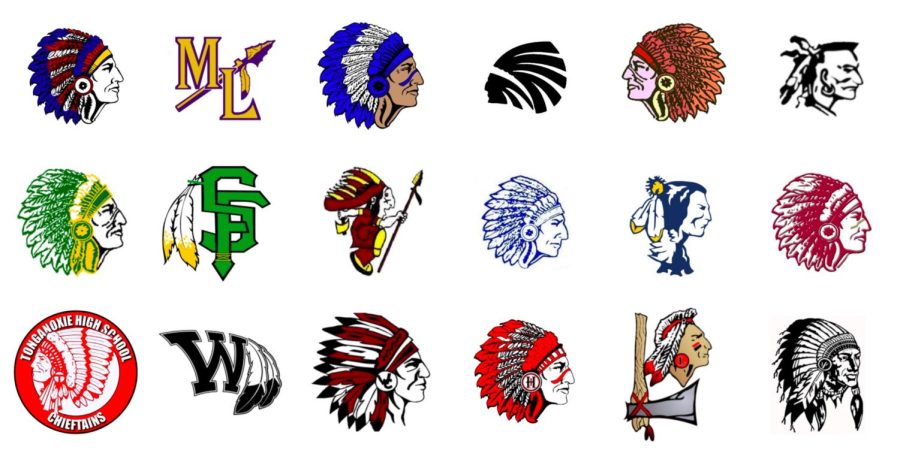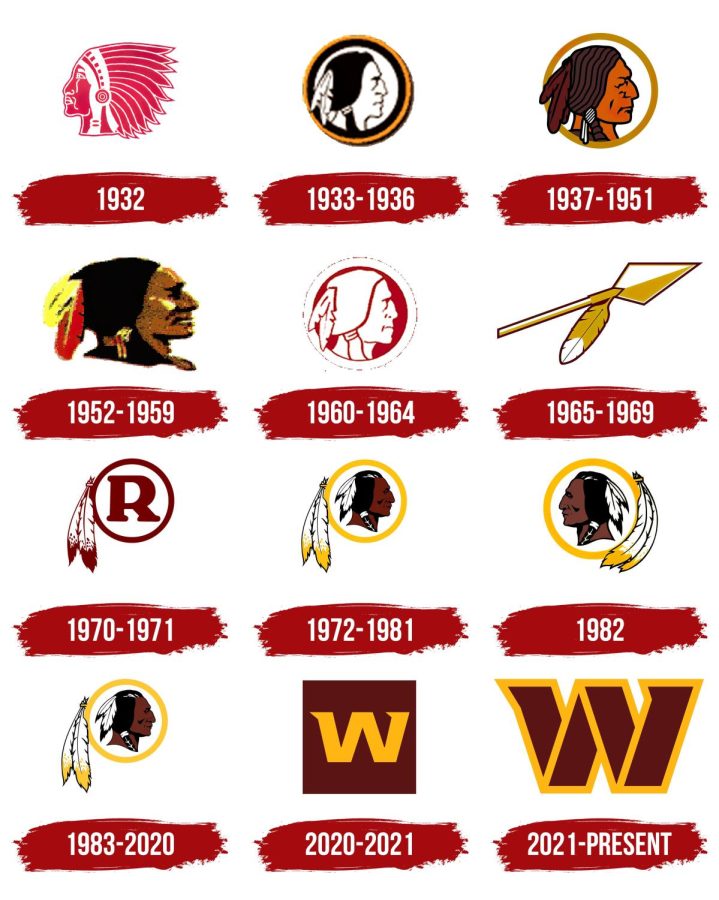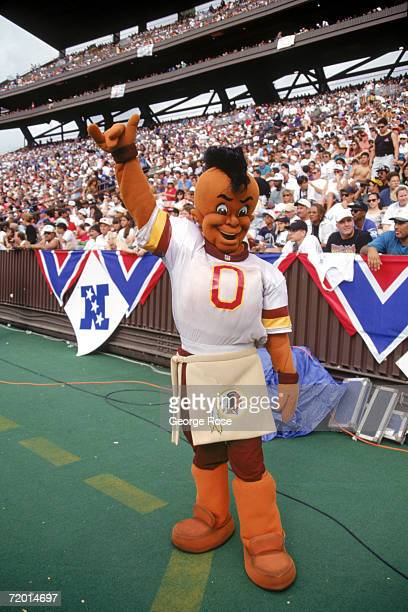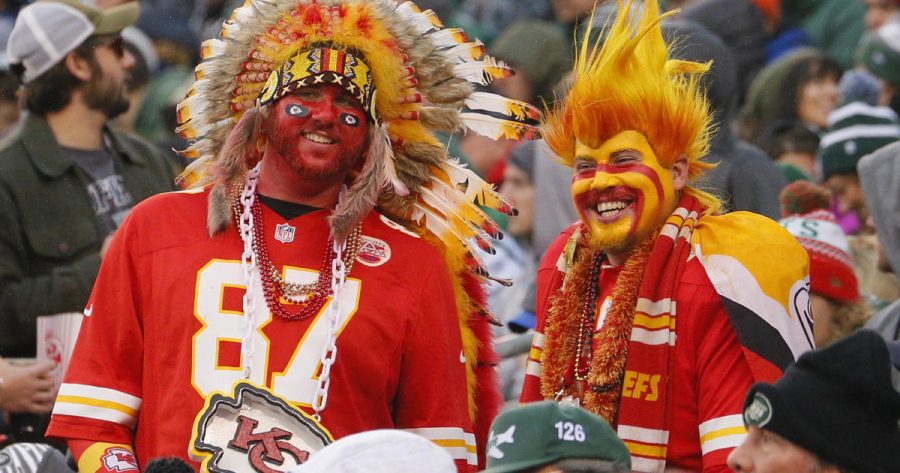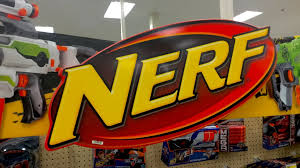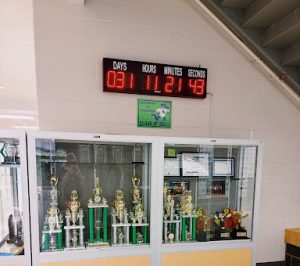Native American Mascots: They’re Just Wrong
May 15, 2023
You’ve probably seen countless sports teams and schools with Native American figures and caricatures as their mascots, and perhaps even felt a little unsettled by it. Chiefs, Seminoles, Redskins, Indians, Utes, Blackhawks, Savages, and more are all Native American-associated names that real sports teams and schools give themselves. Many do it based on their locality, such as if they’re living in an area with a rich Native American history. Some do it to make the statement that their team embodies the “tough” stereotype assigned to Native Americans. Though, no matter the origin of their namesake, these insensitive team names often give way to inappropriate mascots, negative connotations, disrespectful costumes, and more. So, why exactly are these team names themselves inappropriate?
The Washington Redskins No Longer
Perhaps the most notable example of this controversy is the name change of the Washington Redskins Football Team in July of 2020. The NFL team went under fire for their culturally insensitive name around the time of the protests against police brutality and systemic racism sparked by George Floyd’s death. While these protests were mainly focused on combatting discrimination against black people, they reignited some conversations about how other racial minorities are treated unfairly. As outrage about Floyd’s death at the hands of a police officer spread, so did activists’ desire to make change. Statues of racist historical figures were torn down, legislatures were lobbied, and offensive names of schools, teams, and buildings were changed. While the focus of renaming was largely on things with names tied to the Confederate generals and slave owners of our nation’s past, these changes begged the question of other offensive namesakes that weren’t necessarily harmful to just black people.
People began to question the morality of having Native American-associated team names and mascots at all levels of sports and academia. Of course, most attention turned to the most famous professional football league of all. The now Washington Commanders, formerly the Redskins, began to receive masses of backlash from activists, Native American communities, large companies, and football fans alike. The name itself is jarring, but their logo and mascot were what really caused some protest. The team had been using some variation of Native American imagery since 1932, and since 1972 the logo has been the side profile of a Native American man with a braid and feathers in his hair.
Major companies such as Nike, FedEx, and PepsiCo which were known sponsors of the football team were encouraged to put pressure on the team to change their name and logo. FedEx called on the team to make these changes on July 2nd of 2020, and on the same day, Nike removed Redskins merchandise from its website. The following day, the team announced it was reviewing the implications of its team name, and soon after, its name was changed to the temporary “Washington Football Team” as they were working out finding a new one. As this process went on, the team president announced that they planned to break completely away from any Native American-affiliated names that might have caused less controversy, such as “Warriors”. The team has stated that they expect people to still wear old Redskins apparel to games, but that any Native-inspired facepaint, garments, or headdresses will not be allowed in their stadium.
The football team decided on their new name on February 2nd, 2022 (after much deliberation), and called themselves the Washington Commanders. In the associated press release the team made no mention of the racial controversy their past name evoked, but took special care to emphasize the military associations of their new “W” logo. Many were put off by this, as you’d expect some sort of attempt at reparation, or at least a formal apology. Alas, it seems as though the team decided to save face and focus on appeasing another group rather than acknowledging the harm it had done to Native Americans. While the name change itself can be called a win, many activists are not satisfied. Some called the change an “empty gesture,” saying the team seemed to want to brush any shame under the rug as soon as possible and not dwell on it so as to combat the bad rap of the Washington Redskins name.
Why It’s Wrong
This uproar of people speaking out against Native American mascots does call for an explanation of why exactly these things are offensive and harmful in the first place. At face value, in cases like the Washington Redskins it seems obvious, but the racist implications of these team names can often go much deeper than what one might think.
One point that gets brought up often in this kind of discourse is that most mascots for sports teams and schools are animals, or some sort of non-human symbol. Therefore, naming a Native American figure your team’s mascot reduces these people to animals, dehumanizing and barbarizing them. This is especially offensive to Natives, as it reinforces stereotypes older than our country itself. The white Europeans who colonized this continent wrote about the variety of Native American cultures they encountered, often calling them uncivilized and savage for what were to them, unfamiliar practices. Conquistador Bernal“Most of the Indians, particularly those living on the coasts and in the hotter climates, were given to unnatural lusts. To such a dreadful degree was this practised, that men even went about in female garments, and made a livelihood by their diabolical and cursed lewdness.” This kind of portrayal, as we all know, made way for a long, miserable history of oppression and abuse of these Native peoples by white conquistadors and colonizers. This included but was not limited to slavery, murder, rape, displacement, assimilation, and centuries of adding insult to injury, until the Native American population of North America was a fraction of what it once was. This context makes it evident why teams like the (former) Washington Redskins’, and the Kansas City Chiefs’ names spark controversy and give rise to some negative feelings about the implications of using a race as a mascot.
Words Hold Weight
Something else that is important to consider is the connotations attached to specific team names. While all Native-American-based names are dehumanizing to some degree, it could be argued that some are worse than others. While some are named after specific tribes, like the Utah Utes and the Florida State Seminoles, some teams have names/mascots such as Savages, Indians, and, of course, Redskins. While naming a sports team after a Native American tribe is still disrespectful and demeaning, taking a Native stereotype such as savagery and making that your “tough” persona and brand for a sports team is worlds worse. Also, teams named things like “the Indians” are the source of a lot of contention as well. Since Native Americans were given this name by the European navigators who happened upon the North American continent while intending to sail a route to India, it rubs many the wrong way to think that this old misidentification is how these people are defined. This could also bring about the argument that calling them Native Americans, and therefore native to America, the continent that these conquistadors named, is equally as questionable. Alas, while some Native Americans don’t mind the term “Indian”, others dislike it and feel it is outdated, but most can concur that it’s foul to make an “Indian” a mascot.
The name “Redskins” in particular is uniquely horrifying on the basis of its potential origin. The word today is meant to mean Native Americans, at least in the way it is used for sports teams. This of course makes this use of the word wrong based on principle, but where this term may actually come from is even more sinister. There is evidence to support that “red” is what Native Americans referred to themselves as pre-Columbus, and there is also evidence that “redskin” was adopted post-Columbus to differentiate Natives from “white” people from Europe and “black” people from Africa. Though, there is a third theory that would make the Washington Commanders’ old name that much more sickening. A debated etymological claim is that the term “redskin” came about due to the practice of colonizers paying a bounty for Natives’ skin, like they would for pelts, and that “redskin” was used to refer to the bloody scalps of Native Americans. Baxter Holmes of Esquire writes “The story in my family goes that the term dates back to the institutionalized genocide of Native Americans, most notably when the Massachusetts colonial government placed a bounty on their heads. The grisly particulars of that genocide are listed in a 1755 document called the Phips Proclamation, which zeroed in on the Penobscot Indians, a tribe today based in Maine…They paid well – 50 pounds for adult male scalps; 25 for adult female scalps; and 20 for scalps of boys and girls under age 12. These bloody scalps were known as “redskins.” The mascot of the Washington Redskins, if the team desired accuracy, would be a gory, bloodied crown from the head of a butchered Native American.” This point of view is certainly unappetizing food for thought, and while perhaps unreasonable to believe that the Washington team chose this name with evil intentions, they should have known how the name could be interpreted, and how their team name portrays Native Americans.
The Physical Mascots: Walking Caricatures
The physical mascots themselves that go along with these teams are also a big part of the problem. Mascots for teams with Native American names are often either insulting cartoonish caricatures or a person without Native ancestry dressed up in faux cultural garments. The Washington Commanders, in the past, have employed both of these. The team’s older mascot, that is, the kind with a person inside a large suit, has been nearly wiped from the Internet. Only one picture comes up on Google, and its variants are all either blurry or bombarded by GettyImages logos. This goes to show the team’s rightful shame for their past but their lack of public acknowledgment thereof; in other words, they know what they did wrong but beat around the bush when the time was right to own up to it. The old mascot, a suit of a beaming Native American man with a mohawk, boots, and a Redskins jersey is pictured standing on the sidelines during the 1995 NFL Pro Bowl at Aloha Stadium in Honolulu. The artifactual image on gettyimages.com goes for up to $499 to buy a large print of it. If that doesn’t speak for itself, what does?
The Commanders’ more recent but retired mascot was an unofficial one. He was still loved by the team and its fans and was often recognized by the franchise itself. He went by Chief Zee (his real name being Zema Williams) and was an African American man who dressed up in fake Native American clothing and carried a foam tomahawk. Williams was a fan of the Redskins, having attended their games since 1978, and was something of a celebrity to the Redskins’ fans, often being the subject of photo ops and sometimes by opposing teams, violence. He passed away in 2016, much to the mourning of Redskins fans. Though Williams is often blamed for much of the offensiveness of the Washington Redskins franchise, his fake headdress being the source of much of the contention. These headdresses are very sacred to Native American people and carry significant meanings, and ‘Chief Zee’ wearing the costume version of one and adopting that fake title was more than enough to have people accusing him of cultural appropriation. Williams being the face of the team for some time was likely part of why the controversy surrounding the Redskins reached its boiling point.
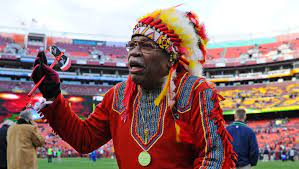
As Williams provides an illustrious example of, these mascots encourage inappropriate fan wear. They normalize adorning knock-offs of culturally significant items and clothing in an innapropriate context, to cheer on a team promoting stereotypes and caricatures of Native American people. A quick Google search of “Redskins fans” or “Chiefs fans” provides anyone curious with countless examples of mostly white fans culturally appropriating Native American body paint and headdresses.
But The Vikings!
A counterpoint that many bring up in discussions about Native American mascots is that there are mascots based on white ethnic groups that no one seems to have a problem with. Examples of this would be the Minnesota Vikings (NFL), whose mascot is based on early Scandanavians, and the Boston Celtics (NBA), which is based on early inhabitants of Wales other parts of Europe. There are multiple online forums in which people are engaging in discourse over this matter, and varying conclusions are reached. This is a fair thing to bring up, considering that the basic principles are the same: a cartoonish version of an ethnic group is depicted, stereotypes are enabled, inaccurate depictions are pushed, a culture is belittled, etc. Though, it is also fair to say that in our country, there is a special historical context that precedes all of us, one that was especially cruel to Native American people, making their associated mascots a rough kind of salt in an already gaping wound. Then again, it isn’t exactly productive to cherry-pick which ethnic-based mascots are acceptable and which aren’t, because to a degree, none of them are okay. They all carry some sort of harmful impact, and while we’re at changing outdated team names, it would be custom to attend to each and every one.
Gen Z’s Take
Some individuals of the younger generation have taken it upon themselves to spread awareness about this issue online, such as Native American TikTok user Lily Joy Winder (@sheshortnbrown). Winder posts information about how to take action against offensive Native high school mascots, providing links to petitions and other resources, as well as videos of herself urging people to take on this cause. Teen Vogue wrote an article about her and her efforts, which puts into perspective the real negative outcomes of these mascots on the high school level.

Conclusion
The principles of the issue of Native American mascots are applicable on many facets, and the negative consequences thereof impact our society in countless ways. It’s of utmost importance to be aware of the implications portrayals of different cultures have, of what constitutes cultural appropriation, and of how our past has shaped our present. If you feel so compelled, seek out some online petitions, or take more direct action wherever you see it needed. It would do us all well to be more cognizant of the humanity of those who are different from ourselves.

